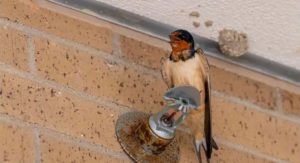With barn swallows beginning their annual migration, a Texas A&M AgriLife Extension Service expert is encouraging property owners to take action now if they want to prevent nesting.
Swallows typically arrive in the southern U.S. by mid-April. Of the eight species in North America, barn and cliff swallows are the most problematic, often building mud nests on homes, barns and other structures. While barn swallows nest in pairs, cliff swallows can form large colonies of hundreds.
Act Before the Nests Are Occupied
Liz Tidwell, a small acreage wildlife specialist with Texas A&M AgriLife Extension, warns that once a swallow begins using a nest, even if unfinished, federal law prohibits removal. The Migratory Bird Treaty Act of 1918 protects these birds, making it illegal to disturb active nests.
“The main reason people want to remove barn swallow nests is aesthetic,” Tidwell said. “Mud nests and droppings can be unsightly and even pose health concerns.”
Swallows near entryways may also become territorial, swooping at homeowners to protect their young.
Preventative Measures
To deter swallows, Tidwell recommends:
- Covering nesting areas with netting or wire mesh.
- Hanging vinyl strips in open entryways.
- Installing bird spikes or barriers to block nest sites.
- Removing old nests before birds return to reuse them.
- Interrupting nest construction by knocking down mud daily before completion.
Tidwell stresses that shooting or trapping swallows is illegal and that attempts to scare them away are usually ineffective.
Safe Nest Removal
Old or empty nests can be removed with a hose, pressure washer, or scraper. Protective gloves and a mask are recommended, as mites and parasites can linger in nests for years.
Reasons to Welcome Swallows
Before taking action, Tidwell suggests considering the benefits of these birds:
- Natural pest control – Swallows eat insects, reducing local pest populations.
- Birdwatching opportunities – Their nesting habits provide an up-close view of their life cycle.
- Educational value – Watching chicks hatch and grow can be a learning experience.
“They’re just temporary guests passing through,” Tidwell said. “They’ll leave when the weather cools.”




